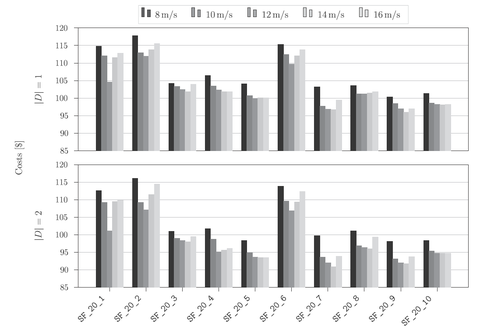11.01.2023
Publikation in Computers & Operations Research zu Tourenplanung mit Drohnen
Wir freuen uns über die Veröffentlichung des Artikels „The vehicle routing problem with drones and drone speed selection“ in der Zeitschrift Computers & Operations Research. In dem Artikel behandeln Felix Tamke und Udo Buscher die durch Drohnen unterstützte Tourenplanung von Paketauslieferungen. Im Speziellen gehen sie auf die geschwindigkeitsabhängigen Energieverbräuche der Drohnen ein und entwickeln für dieses Tourenplanungsproblem einen exakten Ansatz. In einer umfangreichen Rechenstudie mit realistischen Planungsdaten können sie zeigen, dass höhere Geschwindigkeiten nicht zwangsläufig zu kostengünstigeren Touren führen, da die Reichweite einer Drohne mit steigender Geschwindigkeit sinken kann. Dieser Trade-off zwischen Auslieferungsgeschwindigkeit und Reichweite sollte bei Planungsproblem mit Drohnen immer berücksichtigt werden.
Die Publikation kann unter folgender Internetadresse abgerufen werden: https://authors.elsevier.com/a/1gMWA15N8SJNBU
Abstract:
Joint parcel delivery by trucks and drones has enjoyed significant attention for some time, as the advantages of one delivery method offset the disadvantages of the other. This paper focuses on the vehicle routing problem with drones and drone speed selection (VRPD-DSS), which considers speed-dependent energy consumption and drone-charging in detail. For this purpose, we formulate a comprehensive mixed-integer problem that aims to minimize the operational costs consisting of fuel consumption costs of the trucks, labor costs for the drivers, and energy costs of the drones. The speed at which a drone performs a flight must be selected from a discrete set. We introduce preprocessing steps to eliminate dominated speeds for a flight to reduce the problem size and use valid inequalities to accelerate the solution process. The consideration of speed-dependent energy consumption leads to the fact that it is advisable to perform different flights at different speeds and not to consistently operate a drone at maximum speed. Instead, drone speed should be selected to balance drone range and speed of delivery. Our extensive computational study of a rural real-world setting shows that, by modeling energy consumption realistically, the savings in operational costs compared to truck-only delivery are significant but smaller than those identified in previously published work. Our analysis further reveals that the greatest savings stem from the fact that overall delivery time decreases compared to truck-only delivery, allowing costly truck-driver time to be reduced. The additional energy costs of the drone, however, are largely negligible.

